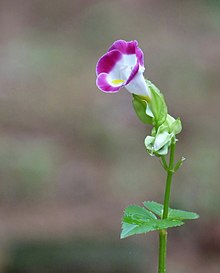| Linderniaceae | |
|---|---|

| |
| Torenia fournieri | |
| Scientific classification | |
| Kingdom: | Plantae |
| Clade: | Tracheophytes |
| Clade: | Angiosperms |
| Clade: | Eudicots |
| Clade: | Asterids |
| Order: | Lamiales |
| Family: | Linderniaceae Borsch, Kai Müll., & Eb.Fisch.[1] |
Linderniaceae is a family of flowering plants in the order Lamiales, which consists of about 25 genera and 265 species occurring worldwide. Vandellia micrantha is eaten in Laos, but tastes bitter. Best known are the wishbone flowers Torenia fournieri and Torenia thouarsii, which are used as bedding plants, especially in the tropics. Micranthemum is sold as an aquarium plant under the name 'baby tears'.
In other classifications it used to be included within family Scrophulariaceae sensu lato or more recently[when?] in Plantaginaceae sensu lato, but several authors have demonstrated that this taxon should be segregated[2][3] from those families, as Linderniaceae,[4] and it has been recognized by LAPG II[5] and APG III.[1] Recently a phylogeny has been published [6] and two new Brazilian genera Catimbaua and Isabelcristinia were recently[when?] added to the family.[7] Studies on the family limits of Linderniaceae are pending.
- ^ a b Angiosperm Phylogeny Group (2009). "An update of the Angiosperm Phylogeny Group classification for the orders and families of flowering plants: APG III". Botanical Journal of the Linnean Society. 161 (2): 105–121. doi:10.1111/j.1095-8339.2009.00996.x. hdl:10654/18083.
- ^ Albach, D. C., Meudt, H. M. & Oxelman, B. 2005. Piecing together the "new" Plantaginaceae. American Journal of Botany 92: 297–315.
- ^ Oxelman B., Kornhall, P., Olmstead, R. G. & Bremer, B. (2005). "Further disintegration of Scrophulariaceae". Taxon 54(2):411–425.
- ^ Rahmanzadeh, R., K. Müller, E. Fischer, D. Bartels & T. Borsch. 2005. The Linderniaceae and Gratiolaceae are further lineages distinct from the Scrophulariaceae (Lamiales). Pl. Biol. ( Stuttgart) 7: 67-78.
- ^
Haston, E., Richardson, J. E., Stevens, P. F., Chase, M. W., Harris, D. J. (2007). "A linear sequence of Angiosperm Phylogeny Group II families". Taxon. 56 (1): 7–12. doi:10.2307/25065731. JSTOR 25065731.
{{cite journal}}: CS1 maint: multiple names: authors list (link) - ^ Fischer E, Schäferhoff, B and Müller, K. 2013. The phylogeny of Linderniaceae - the new genus Linderniella and new combinations within Bonnaya, Craterostigma, Lindernia, Micranthemum, Torenia and Vandellia. Willdenowia 43: 209-238.
- ^ Almeida, E.M., Wanderley, A.M., Santos, A.D.S., DE MELO, J.I.M., Souza, G., Batista, F.R.D.C., Christenhusz, M.J. and Felix, L.P., 2019. Two new genera and species of Linderniaceae (Lamiales) from inselbergs in northeastern Brazil: morphological and karyological evidence. Phytotaxa 400(4):215-226.